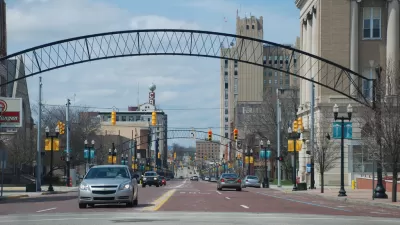A new report outlines seven strategies for balancing economic development and equity specifically aimed at smaller, post-industrial cities.

A Policy Focus Report from the Lincoln Institute of Land Policy outlines how "legacy cities"—post-industrial towns that have largely lost their traditional economic base—"can promote long-term growth while addressing racial and economic inequities laid bare by COVID-19." The report uses case studies to map out strategies guiding "practitioners through equitable investment in both physical projects and people."
As Emma Zehner writes, "[t]he report focuses on small to mid-size legacy cities with populations of 30,000 to 200,000 residents. Though they share many characteristics with their larger counterparts, these cities face unique challenges and require tailored approaches to revitalization." The seven strategies suggested in the report "are tailored to the unique challenges of these small to mid-size legacy cities and also draw on their unique opportunities—such as a lack of market pressures that allows leaders more time to get plans right." Some of the recommendations "build on existing programs—e.g., integrating racial equity analyses into routine local government decision-making—while others stand alone—e.g., programs that build the leadership pipeline and civic capacity of underrepresented groups."
The report's authors emphasize that equity does not have to come at the expense of economic development. In fact, "greater equity can both improve everyone’s access to opportunity and support the economic prospects of cities."
For a deeper dive on equitable economic development in legacy cities, see also the previous iteration of this report, published by the Lincoln Institute of Land Policy in 2017.
FULL STORY: Seven Strategies for Equitable Development in Smaller Legacy Cities

Alabama: Trump Terminates Settlements for Black Communities Harmed By Raw Sewage
Trump deemed the landmark civil rights agreement “illegal DEI and environmental justice policy.”

Study: Maui’s Plan to Convert Vacation Rentals to Long-Term Housing Could Cause Nearly $1 Billion Economic Loss
The plan would reduce visitor accommodation by 25% resulting in 1,900 jobs lost.

Why Should We Subsidize Public Transportation?
Many public transit agencies face financial stress due to rising costs, declining fare revenue, and declining subsidies. Transit advocates must provide a strong business case for increasing public transit funding.

Paris Bike Boom Leads to Steep Drop in Air Pollution
The French city’s air quality has improved dramatically in the past 20 years, coinciding with a growth in cycling.

Why Housing Costs More to Build in California Than in Texas
Hard costs like labor and materials combined with ‘soft’ costs such as permitting make building in the San Francisco Bay Area almost three times as costly as in Texas cities.

San Diego County Sees a Rise in Urban Coyotes
San Diego County experiences a rise in urban coyotes, as sightings become prevalent throughout its urban neighbourhoods and surrounding areas.
Urban Design for Planners 1: Software Tools
This six-course series explores essential urban design concepts using open source software and equips planners with the tools they need to participate fully in the urban design process.
Planning for Universal Design
Learn the tools for implementing Universal Design in planning regulations.
Smith Gee Studio
Alamo Area Metropolitan Planning Organization
City of Santa Clarita
Institute for Housing and Urban Development Studies (IHS)
City of Grandview
Harvard GSD Executive Education
Toledo-Lucas County Plan Commissions
Salt Lake City
NYU Wagner Graduate School of Public Service





























